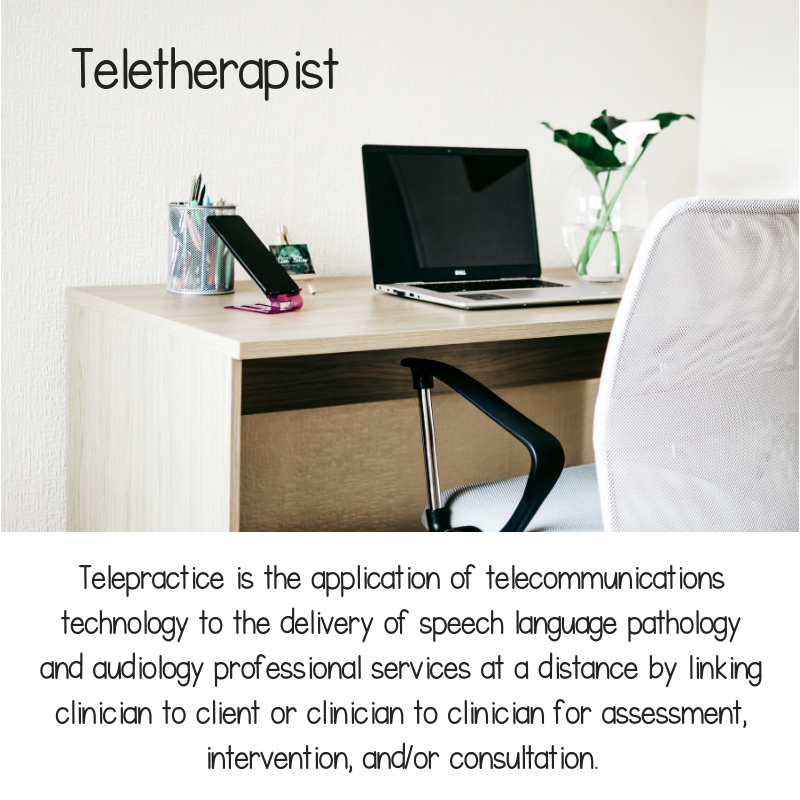
Are you carrying around some disbelief about teletherapy? Maybe you know someone who feels teletherapy services should be provided as a last-resort solution? If so, read on and share my friends! This blog post was written to debunk myths about teletherapy! Let’s keep talking and breaking down the barriers that are inhibiting our students from accessing services! While I respect individuals who have reservations about teletherapy, I am here to help shift perspectives.
Teletherapy is not as effective as in-person services, therefore, should only be used as a last resort.
There is a common misconception that in order for therapy to be effective that the provider and student must physically be in the same room. There is evidence supporting the efficacy of service delivery via telepractice. It can be argued that teletherapy has greater outcomes in specific situations when compared to in-person services. Implementing assessment protocols and intervention via telepractice is similar to in-person services. A highly qualified service provider individualizes their support to assure student progress.
Teletherapy is not secure.
Teletherapy is delivered via a HIPPA/FERPA-compliant platform. As a service provider, it is important for you to do your research and be sure that the platform you are using is secure. There are many video conferencing platforms and not all are created equal in terms of security. When following the right protocols, providers can minimize risk and ensure security when implementing teletherapy.
Teletherapy is impersonal and limits personal connection with the therapist.
Teletherapy is interactive, fun, and engaging. Students actively participate in a face-to-face learning session with the therapist making it easy to establish a positive rapport. Innovation is used to make connections with students virtually. Students are motivated by technology and often look forward to meeting with their providers. Technology also makes connecting with colleagues much easier. With intention, collaborative working relationships with colleagues grow quickly.
Teletherapy has increased disruptions because of technical issues.
Technology is used every day in our personal and professional lives to increase efficiency in our work tasks. Technical issues during teletherapy are minimal as they are in our day-to-day use of technology. Procedures should be in place to mitigate any technical issues when they arise for prompt resolution. We can be confident that the continuity of services will not be inhibited by technical issues.
Teletherapy adds too much screen time.
Individuals who play games online or watch movies are engaging in static screen time. As we know, these activities should be limited. During teletherapy, a provider facilitates the sessions within an interactive video platform. For the duration of the teletherapy session, the provider is actively engaging the child’s brain.

Only select students are candidates for teletherapy.
ASHA has outlined considerations for telepractice that are available for reference in selecting individuals for teletherapy. Selecting clients for teletherapy is an individualized and dynamic process. Students’ participation in teletherapy should not be predetermined based on student needs or prior experience with teletherapy. Individuals may need to be supported by a facilitator with reasonable accommodations to be fully engaged in teletherapy.
Teletherapy requires expensive and specialized equipment.
Teletherapy does not require specialized equipment. The student and provider require a computer, headset, and web camera. The provider would benefit from having a second monitor. The implementation of teletherapy is done with minimal expenses to the provider and client/student.
It is difficult to engage students via teletherapy.
Students are engaged using an interactive virtual platform. Students enjoy computer-based work and a rapport can be quickly established. Service providers are skilled in fostering a positive environment with a rich collection of motivating therapy resources. As with in-person services, a highly qualified clinician has the skills needed to engage students in their therapy sessions.
I hope that this brings clarity and some new outlooks on teletherapy! Teletherapy is not a last-resort solution! IT IS the solution! I created an infographic for you to share with colleagues, administrators, and parents. You can find my Teletherapy Myths Educational Handout in my TPT Store!

Do you have any other myths you want to debunk? Share in the comments! Do you want to know how I got started on my teletherapy journey? Click HERE!









[…] Thank you for stopping by My Teletherapy Room! Don’t forget to check out my blog post “Debunking Myths In Teletherapy”! […]